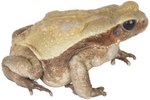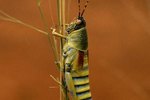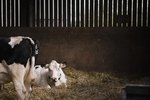
If you've got sheep, goats or cattle, you've got ruminants. The simple definition is animals that chew a cud. Their digestive system differs from other livestock, ranging from horses to hogs. Ruminants have a four-part stomach, although there's a common misconception that they have four actual stomachs. The rumen comprises the first section of stomach.
Entering the Digestive System
A ruminant's food enters through the mouth, is chewed by the teeth, then is swallowed down the esophagus. Unlike non-ruminants, it's natural for the mouth and teeth to experience some of the same food again, in the form of the cud.
Rumen
In any ruminant, the rumen is the largest section of the stomach.Think of it as a large storage and fermentation vat, with numerous sacs. Various "good" bacteria dwell in the rumen, which digests the feed. In the largest breeds of cattle, it can hold as much as 50 gallons. When food is in the rumen, the bacteria digests the fiber, turning it into volatile fatty acids, proteins and B vitamins. Because the rumen boasts a good blood supply, these nutrients are easily absorbed for use by the body. After this part of the digestive process, the "digesta," as the food is termed, heads to the reticulum.
Reticulum
The reticulum looks like a honeycomb. At the meat counter, it's sold as tripe. It keeps large, undigested particles from heading further into the stomach, but these undigested bits go back for rumination. They are then regurgitated, with the animal chewing them again. This becomes the cud, to which the ruminant adds a lot of saliva. When the cud is sufficiently chewed, it heads back down the esophagus. Objects the animal consumed but shouldn't have -- such as metal -- get stopped by the reticulum. Because these metal objects can cause all sorts of damage, farmers might feed their ruminants magnets to keep them in one place.
Omasum and Abomasum
Also known as the manyplies, the omasum resembles book pages. It absorbs water, drying out some of the ingested material between its leaf-like structures. The abomasum is similar to our stomachs, lined with glands and containing digestive enzymes that further break down food. After passing through the abomasum, food exits the rumen system into the small intestine for further nutrient absorption, through the cecum where any previously undigested fiber breaks down, then through the large intestine and out.
References
- Tuskegee University College of Veterinary Medicine: Stomach of the Ruminants
- The University of Edinburgh: Digestive System
- University of Minnesota Extension: Ruminant Anatomy and Physiology
- University of Wisconsin Extension: Back to Basics -- Ruminant Digestive System
- University of Vermont: Exercise 21-- Ruminant Digestive System
Photo Credits
-
Jupiterimages/Photos.com/Getty Images
Writer Bio
Jane Meggitt has been a writer for more than 20 years. In addition to reporting for a major newspaper chain, she has been published in "Horse News," "Suburban Classic," "Hoof Beats," "Equine Journal" and other publications. She has a Bachelor of Arts in English from New York University and an Associate of Arts from the American Academy of Dramatics Arts, New York City.




